Buying Guide: Best Baby Puffs
Baby puffs are one of the most convenient and common finger foods offered to your baby. In this guide, you will find feeding tips for baby puffs and our recommendations for the best baby puffs, baby teethers, toddler puffs, and snacks.
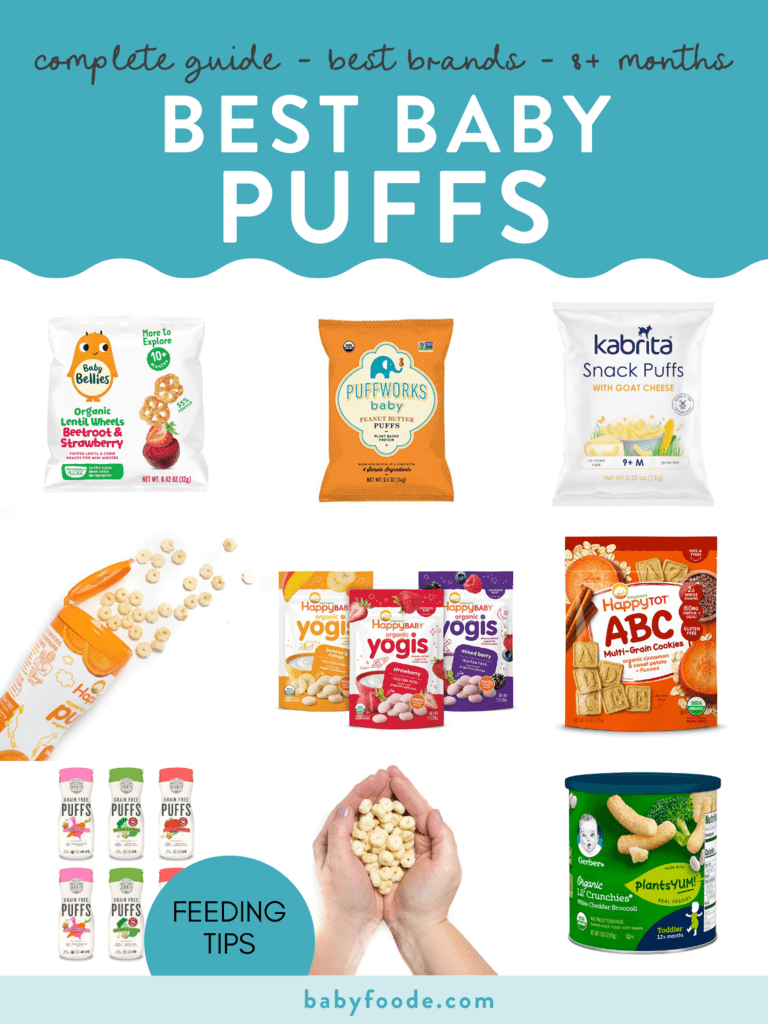
Medically reviewed and co-written by Jamie Johnson, Registered Dietitian Nutritionist (RDN), and Lauren Braaten, Pediatric Occupational Therapist (OT).
Baby Puffs
In an ideal world, we’d all find an extra 10 hours a week to devote to planning, shopping, preparing, and cooking delicious, homemade snacks for our babies and toddlers. (We’d probably use a few hours to sneak in a nice long nap for ourselves, too.) In the meantime, we’ll settle for occasional help from store-bought baby puffs and toddler snacks.
Although baby puffs are obviously not something you’ll be buying your little one forever and are by no means a must-buy product, they can serve some valuable purposes. First, baby puffs are a (mostly) mess-free snack. Baby puffs are perfect when traveling on vacation or out and about on a busy weekend.
Second, baby puffs can be a great short-term “tool” to help your baby work on the skills needed for chewing. And third, puffs can help baby develop their pincer grasp (the ability to pick up small objects using the thumb and index finger), which helps with fine motor skills and self-feeding.
Just starting finger foods with your baby? Then, I would suggest that you start by reading my very in-depth guide – The Ultimate Guide to Fingers Foods, which goes over all the important information such as choking vs. gagging, sample feeding schedule, helpful tools, how to teach baby to chew, has over 80 simple recipes and much much more! You can also check out my best-selling cookbook for even more information and recipes!

Reasons to Love Baby Puffs
- Incredibly convenient to take on-the-go
- Helpful tool for teaching baby the skills needed for chewing
- Dissolve easily, making them a good first food with a lower risk for choking
- Help promote a pincer grasp for more independence with self-feeding and fine motor skills
- Available in a range of fun shapes and flavors
Nutritional Benefits of Baby Puffs
Puffs consist mainly of air, so they aren’t the most nutritious food on the block, however, they do provide some nutrients, which will vary from brand to brand.
- Depending on the brand, puffs may be fortified with different vitamins and minerals, including iron, zinc, vitamin D, choline, vitamin B12, etc.
- Depending on the type of grains, fruits, and vegetables used, there will be some vitamins and minerals from those foods in the puffs.
- The main macronutrient found in puffs is carbohydrates, which are an important source of energy.
- Puffs can help baby master the pincer grasp, which is important in self-feeding.
Frequently Asked Questions
Babies can typically start to pick up puffs once their pincer grasp has developed, usually around 8-9 months.
Technically, babies can choke on anything, however, baby puffs are designed to melt in their mouths very quickly so pose little risk of choking.
Sure, toddlers can have puffs, but I wouldn’t make a habit of it since you don’t want puffs to replace other solid foods that will have more nutritional value and are more age-appropriate for toddlers. Being too reliant on puffs can put babies and toddlers at risk of nutrition deficiencies since they do not provide a whole lot of nutrition overall.
Puffs certainly do not have to be organic but if you are worried about exposure to pesticides, choose organic. If you’re worried about arsenic in rice, unfortunately, organic puffs will not have any less arsenic in them.
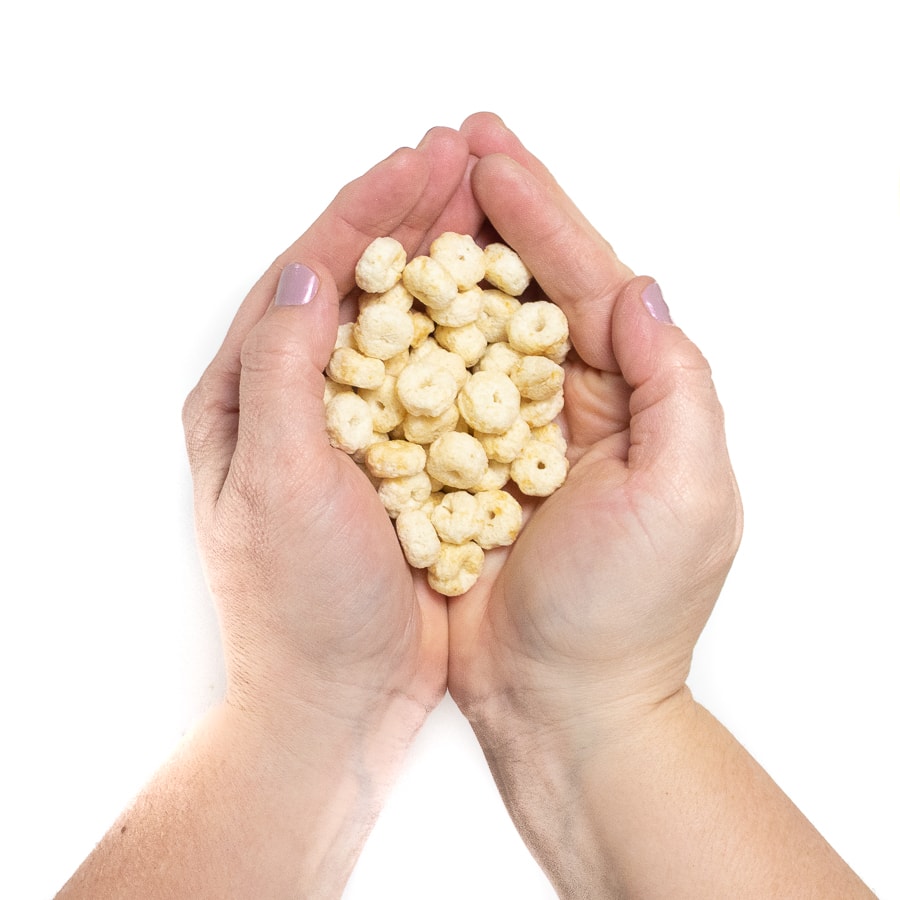
Baby Puffs Storage
Puffs seem to stay freshest the longest by storing them in an air-tight container. Many brands that come in resealable bags don’t always close properly, so it’s best to transfer them to a reusable container with a tight seal.
Puffs Feeding Tips
- Serve a small amount at a time so baby does not shove too many in her mouth at once.
- Vary the type of puffs you buy to get a variety of nutrients and flavors.
- Make sure to buy puffs made from a variety of grains, not just rice, to help prevent too much exposure to arsenic.
- Look for puffs made without added sugar.
- Don’t serve them at every meal and snack so baby does not start to rely too heavily on them.
- You can also soften puffs with breastmilk or formula and spoon-feed to baby.
- Crumble them into a fine powder and roll harder to grasp fruits or veggies in them (such as avocado slices)
- Use them to introduce new foods, such as spreading a very thin layer of nut butter on teether wafers. Or serve larger puffs, such as Gerber Lil’ Crunchies with hummus or lentil puree for dipping.
- Even though puffs melt easily in the mouth, stay in the habit of serving them only when your little one is sitting at the table and you can supervise them.
Rice Based Baby Puffs
Rice has the potential to be higher in arsenic than other grain-based puffs, which is why we recommend serving rice-based baby puffs only occasionally.

Happy Baby Organics Superfood Puffs
Happy Baby Organics are made with non-GMO ingredients grown without the use of toxic persistent pesticides. These Superfood puffs are USDA organic and fortified with 25 mg of choline to support eye and brain health.
- Made with strawberry and beet powders
- Enriched with vitamins and minerals
- Lightly sweetened with real fruit juice concentrate
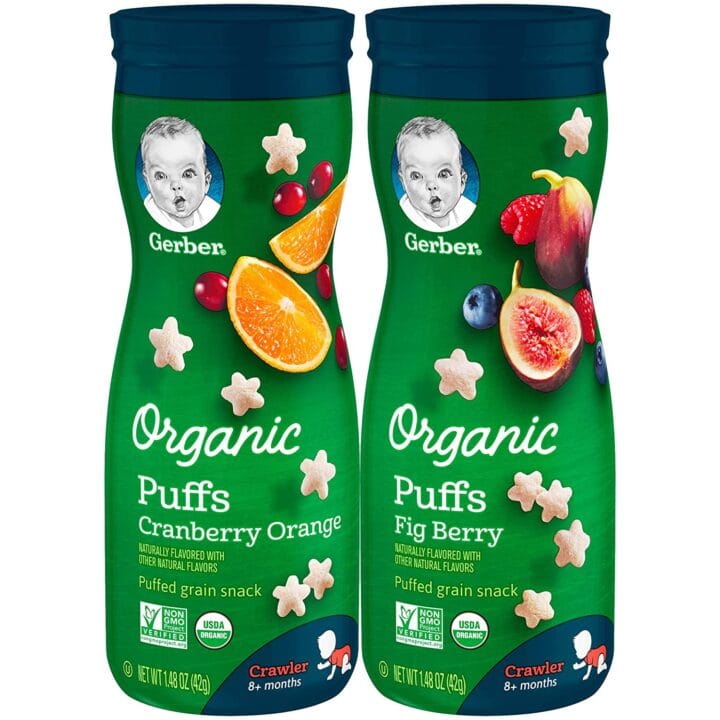
Gerber Organic Puffs
These puffs are made with non-GMO ingredients and have 2 grams of whole grains per serving. They contain 10% daily value of vitamin E, choline and iron.
- Certified USDA organic
- Contains no artificial flavors or sweeteners

Plum Organics Super Puffs
Plum Organics makes a variety of puff flavors, including apple with spinach, strawberry with beet and blueberry with purple sweet potato. Made with BPA-free and recyclable packaging.
- USDA certified organic, non-GMO ingredients
- No artificial flavors or sweeteners
Rice Alternative Baby Puffs
If you are looking for alternatives to rice-based puffs, you’ll find plenty of options made from corn flour, cornmeal, cassava root flour, and whole-grain sorghum.
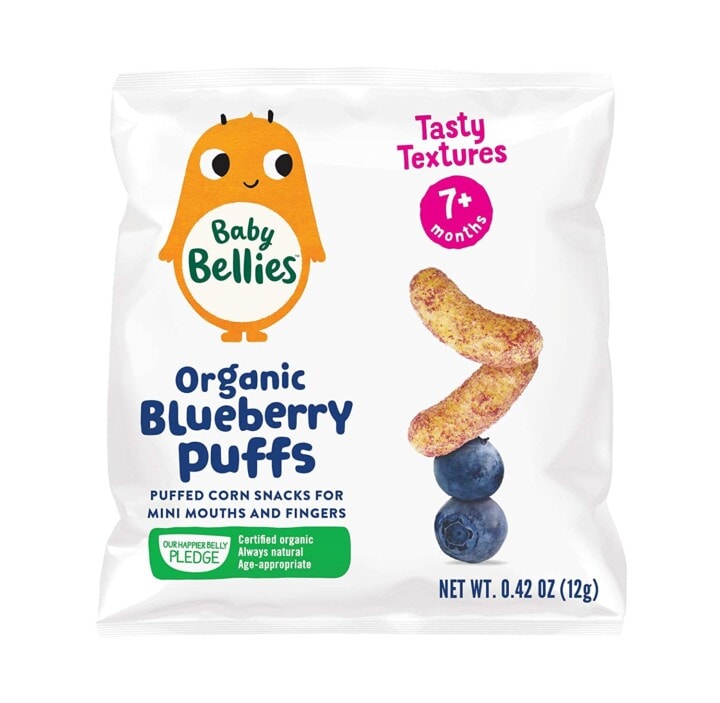
Baby Bellies Organic Puffs
These deliciously crisp organic puffs are ideal for first stage snacking. Available in blueberry and apple cinnamon flavors.
- Certified organic
- Gluten, dairy, soy, peanut and nut free
- Single serve packs are perfect for on-the-go snacking
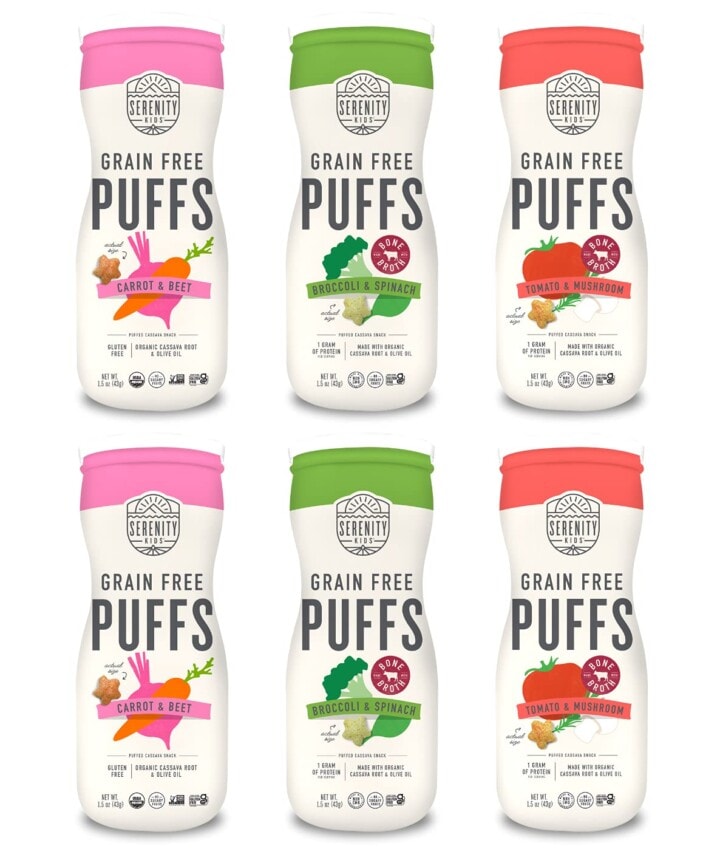
Serenity Kids Grain Free Puffs
Grain and rice-free puffs made from cassava root flour. These savory blends come in a range of flavor combinations, such as carrot and beet, sweet pepper and basil, and tomato and mushroom.
- Made with 0 grams of sugar and olive oil for healthy fats
- Certified Organic & Non-GMO Project Verified
- A family-owned company
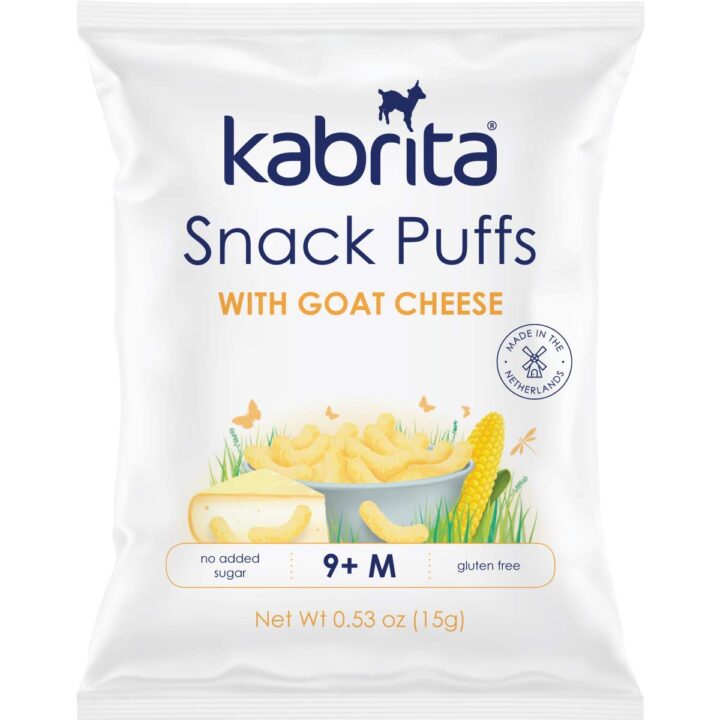
Kabrita Snack Puffs With Goat Cheese
These tasty and all-natural puffs are made with the goodness of goat cheese. Made with organic corn and gluten-free.
- No added sugar
- Free from preservatives, hormones, artificial colors or flavors
- 2 grams of protein per individual bag
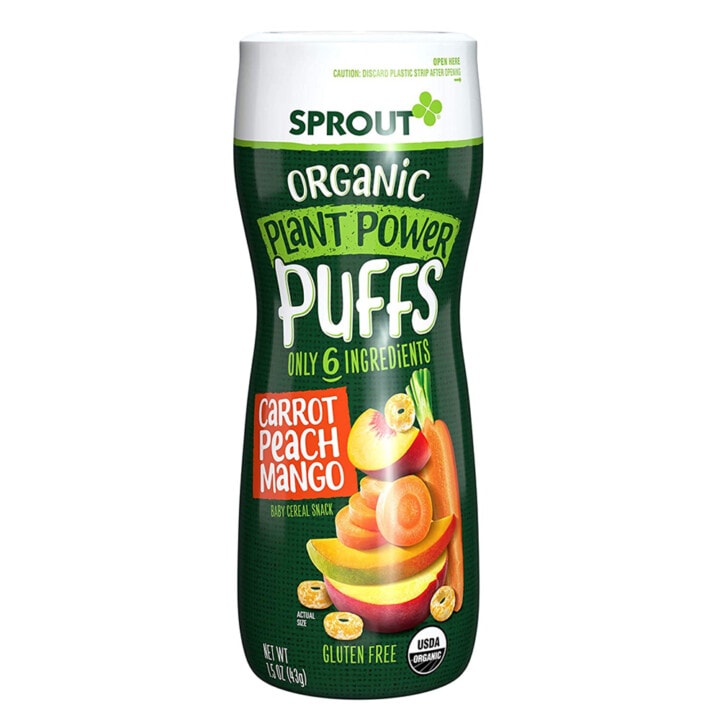
Sprout Organic Plant Power Baby Puffs
These puffs are rice, wheat, and corn-free. Made from organic whole grain sorghum, available in carrot mango, apple kale, and maple cinnamon flavors.
- No added sugar
- USDA Certified Organic, non-GMO, and no artificial flavors
- Packaging is 100% BPA-Free and Recyclable
Baby Puffs with Nuts
Puffs made with peanuts or tree nuts are an easy way to introduce your baby to these common allergens. Pediatricians recommend introducing these allergens shortly after your baby starts solids — as early as 4 to 6 months.
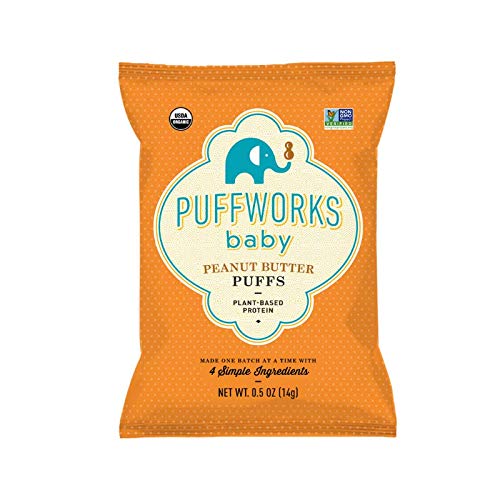
Puffworks Baby Organic Peanut Butter Puffs
These peanut butter puffs are made with simple ingredients. Comes in perfectly sized bags to take on-the-go.
- Low sodium
- Zero grams added sugar
- USDA Organic Certified, Non-GMO Project Verified, Gluten-Free and Kosher Certified
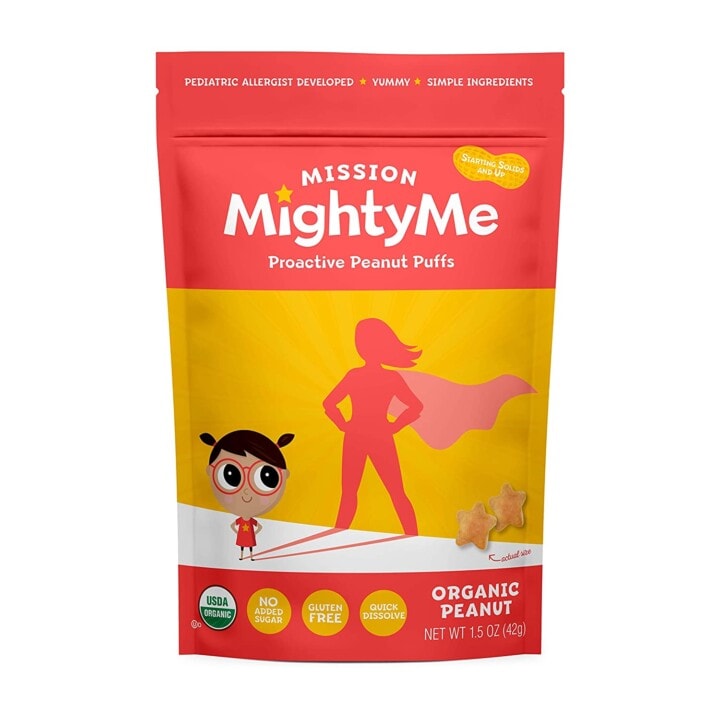
Mission MightyMe Organic Proactive Peanut Puffs
These peanut puffs are made with more than 50% organic peanuts. The co-founder of the Mission MightyMe brand led the LEAP Study. This study found that starting babies on peanut foods as early as 4-11 months, and continuing until age 5, could reduce the risk of developing a peanut allergy by up to 86% for high-risk infants.
- No corn, added sugar, palm oil, preservatives or anything artificial
- Gluten-free, vegan and kosher
- Note that these puffs are also made with organic rice flour

SpoonfulONE Food Allergen Introduction Puffs
SpoonfulONE products were designed to make the inclusion of multiple foods in a baby’s diet gentle and sustainable. Small amounts of common allergenic foods are included in each product to be small, yet impactful enough for your baby’s earliest feedings.
- Includes exposure to common allergenic foods like peanuts, egg, cow milk, tree nuts, wheat, shellfish, fish, and soy
- Free from artificial colors, flavors, or preservatives
- Note that these puffs are made with rice flour
- Please note that if your baby has a reaction to these products, it may be hard to determine which allergen is causing a reaction

Earth’s Best Organic Peanut Puffs
These puffs from Earth’s Best Organic include 3 grams of protein per serving and are made with just 5 ingredients. USDA Certified Organic and Non-GMO Project Verified.
- No artificial flavors, colors or preservatives
- Gluten-free
- Recommended for toddlers 2 years and older
Baby Teethers, Melts & More
Teether wafers and stick-shaped melts are a great option for younger toddlers who want to be more independent with self-feeding. Baby teethers and melts are larger than traditional, smaller puffs and help toddlers with grasping the food on their own.
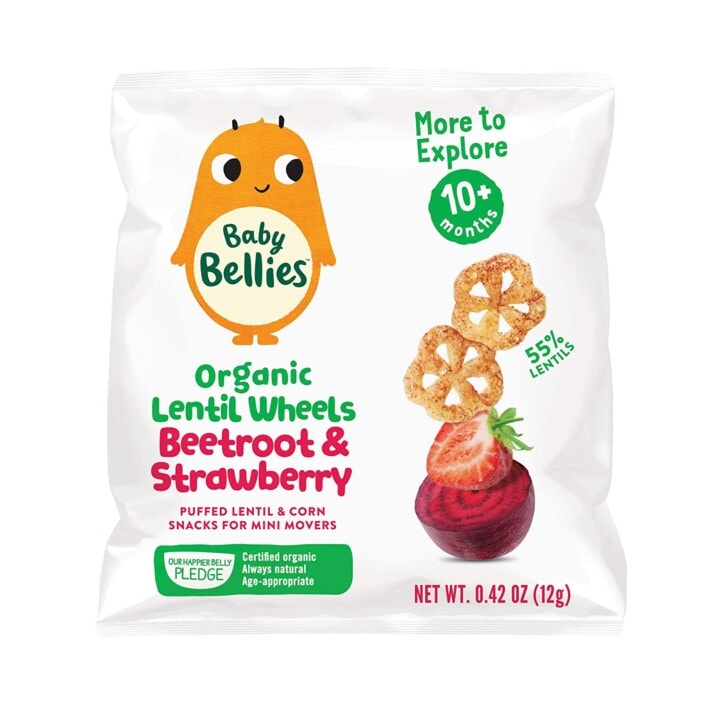
Baby Bellies Lentil Wheels
These crunchy organic lentil and corn snacks are sprinkled with beetroot and strawberry powder for a handy on-the-go snack. These multigrain snacks are ideal for second-stage snacking.
- Soft shapes are perfect for older babies 10+ months to hold in their little hands
- Certified Organic
- Made with organic red lentil and yellow corn flour. Note that organic rice flour is also included further down on the ingredient list.
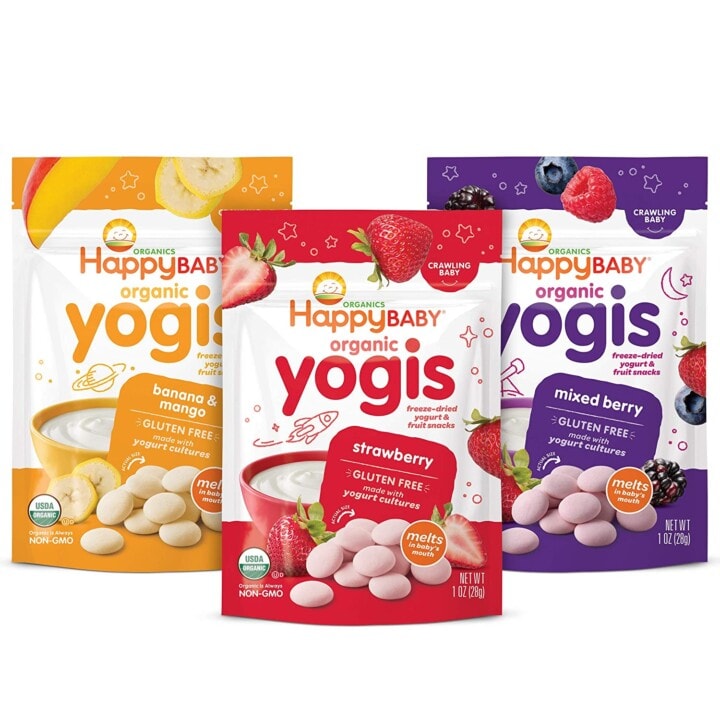
Happy Baby Organics Yogis Freeze-Dried Yogurt & Fruit
Happy Baby Yogis are melt-in-your-mouth, freeze-dried yogurt drops that provide babies and toddlers with a delicious snack that you can feel good about! Made with wholesome yogurt and organic fruit purees.
- Gluten-free
- Certified USDA organic, made with non-GMO ingredients grown without the use of toxic persistent pesticides
- BPA, BPS, and phthalate-free packaging

Gerber Organic Teethers
These teething wafers are for ages 7+ months and have an easy-to grip design for babies who can pick up foods and are learning to self-feed. A yummy way to help soothe your baby’s teething gums.
- 4 grams of whole grains and 2 grams of protein per serving.
- Non-GMO and Certified Organic with no artificial flavors, colors or preservatives
- Note that these are made with rice flour
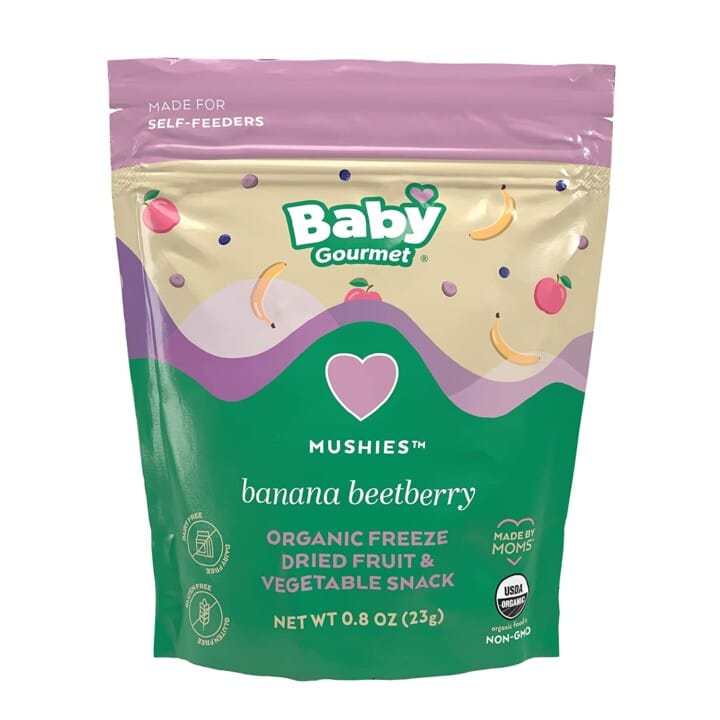
Baby Gourmet Organic Freeze-Dried Banana Beetberry Snacks
Mushies are easy to grab, melt in your mouth freeze-dried fruit snacks made of pure goodness! The banana beetberry flavor tastes like sweet banana and blueberry. Yum!
- No added sugar, gluten-free, non-GMO, no artificial colors or flavors, source of vitamins
- BPA-free packaging and kosher.
- CLEAN LABEL PROJECT PURITY AWARD WINNER – minimal ingredients and rigorous testing ensures the highest product purity and value
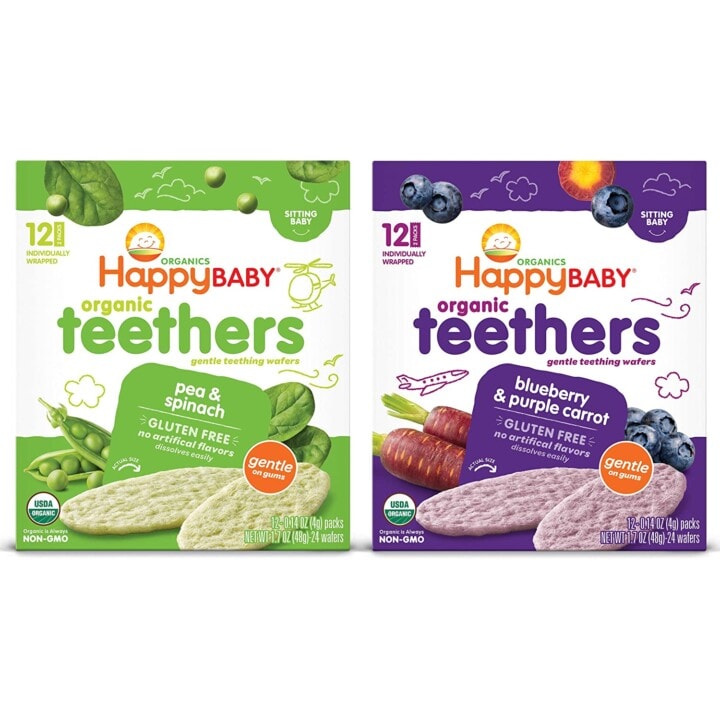
Happy Baby Organics Teether Wafers
These teether wafers are the perfect first snack for your baby’s developing gums. Easily dissolving, organic teething wafers are made with jasmine rice flour, organic fruits, and veggies and contain no artificial flavors.
- Certified USDA organic
- Easy to hold and dissolve
- Although they are made with minimal ingredients, that does include rice flour
Toddler Puffs and Snacks
For the toddler stage, it’s nice to have quick and (mostly) mess-free options. Toddler puffs and snacks can be helpful for busy parents, just try to use these products sparingly. These products should not be a regular substitute for other solid foods that have more nutritional value for toddlers.

Sprout Organic Curlz Toddler Snacks
Sprout Organic Curlz are the FIRST plant-powered snack for toddlers, made from organic chickpeas and lentils and baked to perfection with savory broccoli.
- Available in three flavors: Broccoli, White Cheddar, and Sweet Potato & Cinnamon
- Baked and preserved only with organic rosemary (does not affect flavor)
- USDA Certified Organic, non-GMO, and contains nothing artificial

Baby Gourmet Organic Puff Snacks – Carrot Sticks
Plant-based carrot “puff” sticks are full of protein, iron, vitamins, and minerals as well as probiotics to support gut health. Made with red lentil and chickpea flour.
- Free from most allergens and no artificial preservatives
- No added sugar or salt, non-GMO, gluten-free, BPA-free packaging, and 1 billion probiotics per serving.
- CLEAN LABEL PROJECT PURITY AWARD WINNER – minimal ingredients and rigorous testing ensures the highest product purity and value
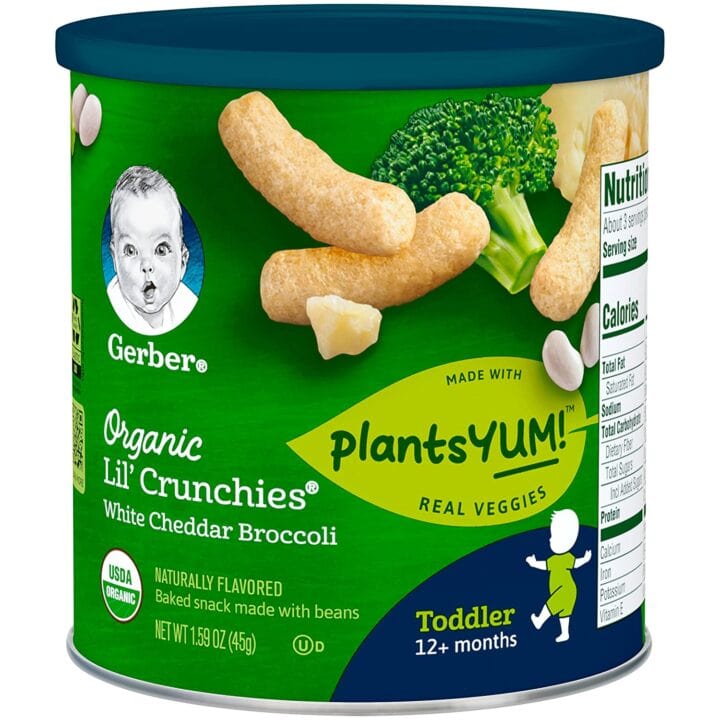
Gerber Organic Lil’ Crunches
This baked snack will melt in your baby’s mouth with a flavor they’ll love. They’re quick dissolving and come in the perfect size for tiny hands.
- Made with real navy beans and 2 grams of protein per serving
- An ideal snack for an baby learning to self-feed, 8 months and up
- No artificial flavors or artificial sweeteners, non-GMO

LESSEREVIL Organic Sweet Potato Apple Lil’ Puffs
These tasty little puffs are made with a base of organic cassava flour, coconut oil, and an organic protein blend, making them a treat that you can feel good about serving.
- Certified Organic, gluten-free, and non-GMO project verified
- Low sugar and grain-free

Earth’s Best Toddler Baked Corn Organic Puffs
These veggie puffs are made with organic ingredients grown from the earth – no artificial flavors, preservatives or potentially harmful pesticides.
- Made with simple ingredients, including 6 kinds of organic veggies and real organic cheddar cheese
- Certified USDA organic, gluten-free and non-GMO project verified
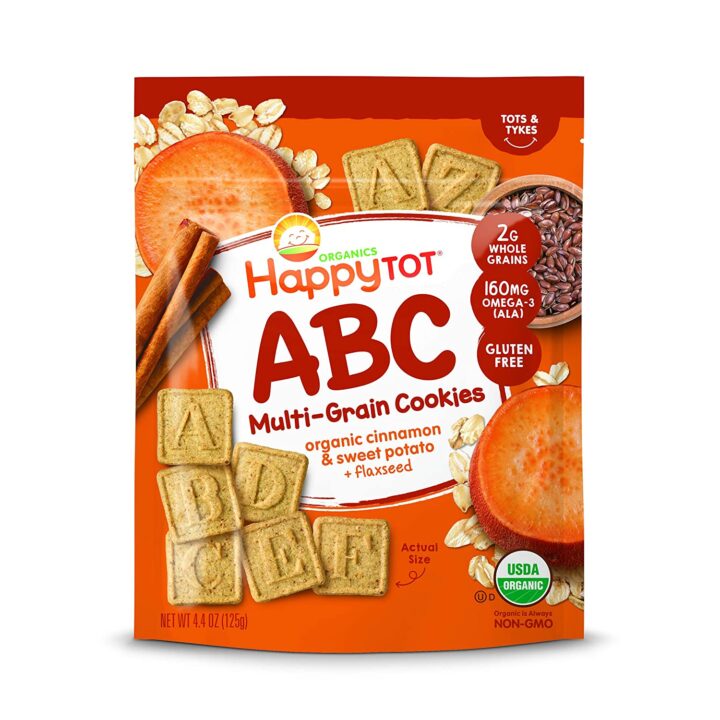
Happy Tot Organics ABC Multi-Grain Cookies
These multi-grain alphabet snacks deliver organic ingredients and 160 mg of Omega 3 (ALA). Featuring alphabet letters, these toddler snacks are a yummy, creative way to learn ABCs.
- Delicious cinnamon, sweet potato and flaxseed flavor
- Certified USDA organic, non-GMO ingredients grown without the use of toxic persistent pesticides and in packaging made without BPA, BPS, or phthalates
- Note that these are made with brown rice flour, in addition to buckwheat and oat flours

2 Comments on “Buying Guide: Best Baby Puffs”
I found that the happy baby teethers caused my granddaughter to have constipation which she already has an issue with since she was born every time we changed brands of formula since it was always out of stock. Do the puffs most likely cause constipation as well? Is it the preservatives that is causing it?
Baby puffs shouldn’t cause constipation but definitely consult your pediatrician about your concerns. xo, Michele